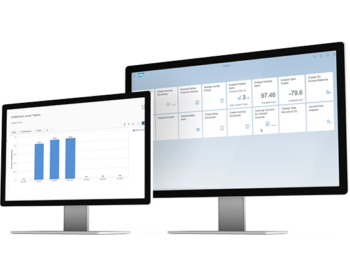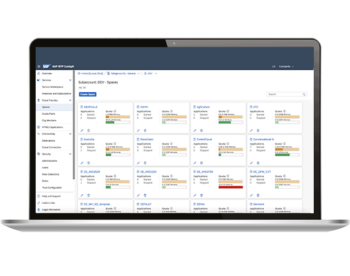The publication NTT DATA Technology Foresight 2023 emphasizes the significance of the direct impact of the use of software on a company’s development. IT is at the heart of business processes, and the tools used ensure that decisions are taken on the basis of collected data. Cloud-based solutions represent the leading technology, and this also applies to ERP systems.
Cloud Strategy – The 10 Most Important Elements

Unlocking the Potential of Cloud ERP: Key Considerations for Your Cloud Strategy
The trend towards cloud-based solutions is confirmed by the Gartner study “Cloud Shift”, according to which 65% of expenditure for application software will be directed toward cloud technologies in future. According to a study conducted by NTT DATA Business Solutions entitled “Challenges on the way to the factory of the future”, the use of cloud solutions is among the top 10 of the most important elements of the digital transformation. The survey report shows that such technologies are used by over 50% of the surveyed companies. We decided to take a look at a strategy that includes cloud ERP as an important element.
Which aspects should be considered in the preparation and implementation of a cloud strategy?
1. Scenarios for Converting to Cloud ERP
One of the things first prompting a company to consider changing to a cloud-based solution is often the relationship between the existing on-premise solution and its functions (namely: the limitations of such a solution). The decision to initiate the process of migrating to a new model is taken after a comprehensive analysis of the infrastructure, frequently timed to coincide with the end of the life cycle of the old environment, combined with a process of budgeting, upgrading and procurement.
It is during this phase that the question of choosing between IaaS, PaaS and SaaS models arises. These services differ in terms of the service scope and the division of responsibilities between customer and provider.
With the model of ERP provision by a cloud partner, the partner takes on full responsibility for the entire solution. The customer is given a license and is able to make use of a number of cloud benefits, such as dynamic resource adjustment.
2. Avoid Making Mistakes in Your Cloud Planning
With any project, including cloud migration, mistakes are costly. If mistakes are made with respect to the IT system landscape, it may become impossible to take advantage of the tangible benefits of the cloud – even those that had been anticipated at the beginning of the project. Such mistakes cannot be corrected easily, and it will be necessary to take a step back and plan the architecture new.
3. Standardization
One of the aspects of modern cloud ERP systems, like SAP S/4HANA Cloud, is a reduced need for contact with the cloud provider. Companies see an opportunity in the standardization of solutions based on the partner’s experience combined with the adaptation of their own business processes, enabling easy subsequent updating. By opting for tried and tested practices and calling upon the expertise of external consultants, it is possible to find areas where the business can stand out and gain greater benefit.
4. Portfolio of the Most Important Solutions
A company’s IT ecosystem comprises numerous interlinked solutions. Cloud ERP offers an efficient way to integrate these, thanks to the solutions of so-called hyperscalers, among other things. Their tools offer scalability, security and flexibility.
The development of an environment based on cloud logic involves the implementation of integrations, applications and front-ends with the aim of becoming independent of the central system. This is possible thanks to standardized universal functions and tools developed in the cloud. Use of such capabilities is particularly important in a changing business environment.
5. Building Up Competences
Good planning of architecture and services facilitates sophisticated management of costs and subscriptions. It is important in this context to gain experience and know-how about the services to be used. The lack of such know-how is a challenge for many organizations.
Another point to mention here is the question of data security in the cloud. There are numerous tools, architecture guidelines and certifications on the market. However, the capability of making good use of them depends on the level of awareness and knowledge of these topics within the organization.
6. Network Considerations
Access to systems and data is of fundamental importance for business continuity. When a company manages processes relating to production, transportation or warehousing centrally, methodical planning of the network infrastructure is important in connection with the migration to the cloud. Methodical network planning at the beginning of a project will minimize the risk of unexpected costs arising at a later date.
It is crucial that the most important processes are properly adapted to ensure uninterrupted operation in the cloud. Project managers need to understand the production and business processes of the organization in detail in order to develop a suitable model for maintaining the most important systems operational at all times. A hybrid cloud model in conjunction with integration of the internal infrastructure with the cloud or with several cloud solutions represents a common choice. The activities should be well-planned in order to avoid delays and data transfer costs.
7. Access to Tools
There are many tools on the market for communication with the cloud. A high level of awareness of the issues relating to integration with such an environment can most frequently be found in multi-branch companies that have practical experience of integrating their own resources. Network resources in distributed organizations generally facilitate a faster move to cloud computing. In centralized single-branch companies, by contrast, such a migration tends to be more of a procedural challenge, and frequently requires investments in technology and know-how.
8. Benefit Planning
No doubt the technological sophistication of an organization is of great importance when aiming to realize the benefits of the adoption of the cloud model and the implementation of cloud ERP. The main, and most immediate, benefit is scalability, available upon completion of the migration project. A further element is the cost benefit; this does, however, depend on the optimization of the services and their utilization. Cloud solutions should be regarded as an “investment” that enables organizations to realize benefits that are impossible to achieve otherwise.
9. Fast Response to Unexpected Situations
Economic uncertainty represents one of the biggest challenges for companies today. It is important to respond appropriately to dynamically changing market conditions. Cloud technologies offer a great advantage in terms of the capability of adapting the digitalization strategy continually to the external environment. It is becoming ever more important to find a space that offers speed and flexibility for the processes within a company.
Such a space should make it possible to respond to the company’s business requirements with agility, shortening the time “from idea to solution” and allowing faster implementation of improvements. It can be equally significant to be able to restructure expenditure – it is important to move the focus from the infrastructure to new technologies and innovative areas. Applications should be managed using automation, enabling the simplification and speeding up of the business processes.
10. The Cloud as Part of the Strategy
Thanks to the RISE with SAP offering provided by NTT DATA Business Solutions, migration to the cloud can be achieved with greater speed. This involves a package comprising several solutions and services. A comprehensive approach for migration projects should cover three fundamental aspects: requirements analysis and design, orderly data migration based on a fixed schedule, and management of the IT environment that is proactive in addressing potential risks and needs.
Investment in long-term measures makes for outstanding application availability, business flexibility and business continuity. This strategic framework also encompasses problem management, the optimization of SAP applications as well as innovative approaches for business processes.
Prioritize the Requirements of Your Own Company
The conversion to cloud ERP represents a great challenge that should be preceded by a thorough requirements analysis, which customers look for and expect. Advanced solutions for key systems require time and, above all, an understanding of the relevant aspects of each system in the context of your own company. By preparing the migration project properly from the start you can avoid mistakes and take advantage of all potential benefits while your systems run in the cloud.
Would you like to learn more about cloud solutions for your company?
*This article is based on an interview: “We act as a guide to the world of the cloud for our customers”, which was published on itwiz.pl.












